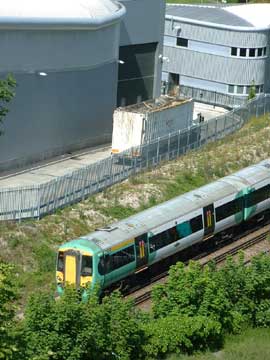Life near the Dump
video clip 1 Life near the Brighton MRF/WTS [1 min 3 sec]
video clip 2 Protest march against the siting of the Waste Transfer Station at Hollingdean Depot - 17 June 2006 [4 min 15 sec]
1. Hollingdean Depot - where to complain?
3. Where Veolia is to be encouraged
4. Action taken so far by The Environment Agency
5. The WTS has no entrance airlock system
6. The Visual Impact on the conservation area
7. Breaches of planning condition 16 [1 min video clip]
8. Tipping while the doors are open
10. Noise impact Assessment not robust
What specifically do residents want planners and political representatives to address?
Hollingdean Depot - where to complain
Troubled by noise, smell or dust from The Waste Transfer Station at Hollingdean Depot? Phone (free from landlines):The Environment Agency on 0800 80 70 60 since it is they who set and control the terms of Veolia's licence. The system of monitoring is complaint-led, so if you want The Environment Agency to understand the extent of the problem, you need to let them know each time you feel unreasonably affected by
- odour escapes (see section 3.4 of operating licence)
- industrial noise - for example, repetitive beeping from old-style reversing sirens unauthorised on site - is a failure of Hollingdean Depot's site manager to prevent or minimise noise disturbance, contravening section 3.5 of the EA's operating licence as well as breaching the Council's own planning conditions
- fugitive emissions (dust or smaller particulates)
see section 3.3 of the EA's operating licence
from Hollingdean Depot. If 3 households complain about the same incident on the same day, they will investigate.
Follow-up of your complaint
If you have already complained to 0800 80 70 60 and you want to know what follow-up action has been taken, phone The Environment Agency's General Enquiries number on 03708 506506.
Action depends on sufficient complaints
The Environment Agency will come out to witness the odour on days when they receive three separate complaints. Monitoring is complaint-led. No complaints and the EA will assume that residents are happy. As the operating licence makes clear, The Environment Agency is the body which needs to know about unreasonable noise, odour, escapes of dust, etc from Hollingdean Depot. We do not recommend complaining to Veolia or The Council.
Phone the EA on 0800 80 70 60 instead.
The Environment Agency (see their factsheet) takes a special interest in Round Hill's concerns. After your complaint has been officially logged, you might want to ask if they could give you a call back to explain the problem and say what is being done. They will give you a reference number for each complaint.
Is it worth complaining to Veolia directly?
You can inform Veolia's Site Manager about odour &/or noise by email phone 01273 544 205) or write to Hollingdean MRF/WTS, Veolia Environmental Services (UK) Plc, Hollingdean Lane, Brighton BN1 7BB. However, ensure that your complaint is made first to The Environment Agency 0800 80 70 60 so that it is logged by the licensing body which permits Veolia to operate.
Food waste and the law
Following The Environment Act of 2021, all Councils are compelled by law to have introduced separate food waste collections by 2026. Brighton and Hove City Council plans to phase in such collections between the autumn of 2025 and March 2026, though residents are already asking where the food waste will go directly after it has been collected. They hope it will not be to a building unfit for storing odorous waste near to residential homes and gardens. That regrettably is the plan!
Where Veolia is to be encouraged:
1. To Veolia's credit, they state on their website their commitment to better ways of using food waste (i.e. producing renewable energy using an Anaerobic Digestor).
Tea Meneghetti, a resident from Brighton's Hanover district, organised a petition signed by 4,200+ people, calling for Brighton and Hove City Council to recycle a wider range of plastics as well as food waste. Councillor Leo Littman disclosed that 30 per cent of the waste sent for incineration at Newhaven was food, which he described as obscene.
However, Separate Brighton and Hove City Council food waste collections are to be phased in from the autumn up until March 2026.
Moreover, also to be phased in until March 2026, residents of Brighton & Hove will be able to put a wider range of materials in their household kerbside or communal mixed recycling collections, including plastic pots, tubs and trays – such as yoghurt pots, fruit trays/punnets, margarine tubs, and soup pots, food and drink cartons – including Tetra Paks (fruit juice, plant-based milks etc.), gravy tubs, crisp tubes, kids drink cartons, and soup cartons, and aluminium foil and foil trays.
See former Brighton Pavilion MP Caroline Lucas's 2018 request to Michael Gove to talk to Veolia about varying its 30 year PFI contract with Brighton and Hove City Council in order to recycle a greater range of plastics. Note, however, that Cllr Tim Rowkins, Brighton and Hove City Council’s current environment lead, refutes claims that the reason we can’t recycle more items is because of the contract with Veolia. He states that the limiting factor has been the size and configuration of our Materials Recovery Facility.
Read Brighton and Hove City Council Cabinet Paper pages 23-34: increasing recycling and introduction of food waste collections - prepared for their meeting on 15th May 2025.
See also:
- WRAP's article on:
understanding household food waste uk - Jane Wilde's presentation on the use of food waste for Community Composting. She states that the very worst thing that we could do with food waste is to incinerate it together with other black bag waste.
The incineration of 3000 tons of food waste requires 870 tonnes of water - water which could be saved for far better uses.
There is great scope here for improving our management of waste in Brighton and Hove. Food waste accounts for 25%-30% of the waste stream (our black bag waste). Together Kitchen and Garden accounts for betwen 30-35%. By separating out this waste, which should not really be with the rest of the black bag waste, the 65%-70% which remains in the black bag will be a lot cleaner. This will make Materials Recovery and Recycling a lot easier.
Instead of incinerating food waste, it is an improvement that Veolia will send it to the In-Vessel Composting facility near Uckfield. However use of an anaerobic digester (as floated on Veolia's website) would capitalise fully on the value of food waste, which inherently has a high calorific value. While aerobic digestion produces compost to enrich soil, it does not generate energy. Anaerobic digestion, however, takes things a step further by producing renewable energy in the form of biogas (in addition to the soil-enriching digestate). The biogas can be then converted into electricity, heat, or fuel. While explaining the new arrangements for food waste collections, Satti Sidhu Acting Head of Strategy and Service Improvement | Environmental Services, Hollingdean Depot states:
The goal of separate food waste collections should be anaerobic digestion. There is surely a need for more Anaerobic Digesters, but incentives to build them need to be given by Local Authorities responsible for food waste collections. Hopefully, the requirement under the Environment Act of 2021 that all councils must offer separate food waste collections by 2026 will encourage this.
2. Veolia is also to be congratulated for improvements at their Wilson Avenue recycling site where residents of our city can support good environmental practice by [1] contributing garden waste &/or [2] buying Veolia's Pro-Grow garden products (soil & lawn conditioner / peat-free multi-purpose compost / woodchip mulch / bark chips / etc). Fortnightly garden waste collections from your home are available through The Council for £94 per year.
Action taken so far - diagnosis & solution
The Environment Agency responded to residents reporting odour nuisance from The Waste Transfer Station during the period August 2013 to August 2014 through a written letter.
Chris Parkin from the government's Environment Agency has identified the 2 biggest problems which cause odour nuisance - "the design of the building and the nature of the waste received. The primary odorous source is the food waste contained within domestic refuse. The only possible way to remove that is for the local council to instigate separate waste collections for food waste, which would be a huge undertaking for them."
The design of the building is the other primary contributing factor. Most odour complaints arise when the doors to the WTS are opened, particularly in the morning. The building was built without an entrance airlock system, so there is no barrier between the waste and the open air when the doors are opened and this allows odour to escape. Veolia have also identified that odour has been escaping through the vents designed to let air into the building.
During the large fire at the WTS on 25th August 2019 (the first of three recent fires there) residents saw smoke escaping through the same vents, which increased their understanding of odour escapes.
The verdict of the officer from The Environment Agency who was assigned to investigating odour nuisance from the Hollingdean Waste Transfer Station between August 2013 and August 2014 is that the building cannot contain the odour from a constant stream of food waste and that separate food waste collections taken elsewhere for processing is the only complete solution.
The findings of The Environment Agency undermine the promise made at the meeting on 23rd June 2005 at the Downs Infants School to allow experts representing Onyx (now Veolia) to speak about the anticipated impacts of their scheme for a Waste Transfer Station and Materials Recovery Facility at Hollingdean Depot Brighton. Referring to the proposed Waste Transfer Station, Roger Barrowcliffe from ERM assured us that
A complete written transcript of this meeting is posted at https://roundhill.org.uk/main?sec=planning&p=Veolia_2005-06-23_Public_Meeting.
We were not given a state-of-the-art facility. The Brighton Society aptly described Veolia’s installations as “basic metal sheds, the cheapest form of building”. The Waste Transfer Station has never been fit for the purpose of storing odorous waste.
The WTS has no entrance airlock system
Click HERE for more on how the absence of an airlock entrance system (i.e. a sealed vestibule with two sets of doors) makes the Hollingdean Waste Transfer Station an inferior installation, since airlocks are standard best practice in modern waste management facilities, not only for odour but also for dust, vermin, and bioaerosol control. Bioaerosol control means minimising escapes of airborne biological particles, such as bacteria, fungi, and viruses, in the air.
Note that the absence of an entrance airlock system (also called an airlock entry system) at the Hollingdean Waste Transfer Station ignores best standard practice. Waste transfer stations typically rely on maintaining negative air pressure inside the building to keep odorous air from escaping. Without an airlock, each time a waste truck enters or exits, that pressure is disrupted, allowing foul air to escape directly into the surrounding environment.
To review best standard practice, go to Non-hazardous and inert waste - appropriate measures for permitted facilities on the Environment Agency's website. See under EMISSIONS CONTROL - Enclosure within buildings Page 27 (sections 186 recommends installing an airlock entry system to minimise fugitive emissions) and page 29 (section 200 recommends the use of fast-acting or ‘airlock’ doors that default to closed).
The absence of an airlock entry system overshadows lesser attempts at odour management. The problem remains unsolved:
Activated carbon filtration for the Waste Transfer Station was abandoned as unlikely to be effective (building too porous and too big). Veolia then looked into a UV lamp/ozone system for breaking down odour molecules, but this too was abandoned.
- New technology to eliminate waste stations' stink -The Argus, Thursday January 3, 2013
Veolia trailed the new technology in the local paper as a great solution. Subsequently, I learnt on the phone from Bunmi Aboaba of the Environment Agency that the UV lamp/ozone system for breaking down odour molecules was never installed in The Waste Transfer Station since the Environment Agency considered the system unsafe in a place where there are people around. The problem remains a building unfit for the purpose of containing the odour from rotting food waste.
Visual impact on conservation area
Proposed green roof and green walls never included in the MRF
The green roof and green walls proposed for the Hollingdean Materials Recovery Facility (MRF) were part of the original design intentions but were not formalized as enforceable planning conditions in the approved application BH2006/00900 in June 2006. These features were ultimately not implemented.
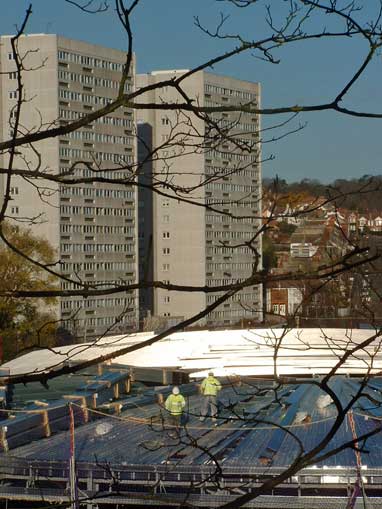
While the initial planning documents and architectural plans included these green infrastructure elements to enhance sustainability and visual integration with the surrounding environment, the absence of specific conditions mandating their implementation meant that their inclusion was not legally required.
The lack of enforceable conditions regarding the green roof and walls has been a point of contention among local residents and environmental groups, who have expressed concerns about the facility's environmental impact and the perceived deviation from the original sustainable design commitments.
No space to the south of the site to landscape the WTS
Landscaping south of Waste Transfer Station stripped away You would expect planning conditions to require more landscaping when a Waste Transfer Station is sited next to a residential community.
The Round Hill conservation area ended up with far less, especially along the Coastways railway corridor, which separates Hollingdean Depot from our homes and gardens and is an important habitat for wildlife. Although the removal of trees on the south side of the railway by Network Rail in 2005 pre-dated Veolia's installations, the north embankment of this designated greenway was stripped of trees while the MRF, WTS and Visitors' Centre were being constructed.
Land to the rear of 67-81 Princes Rd in September 2004 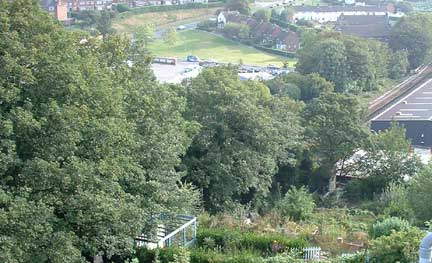
Land to the rear of 67-81 Princes Rd in October 2007 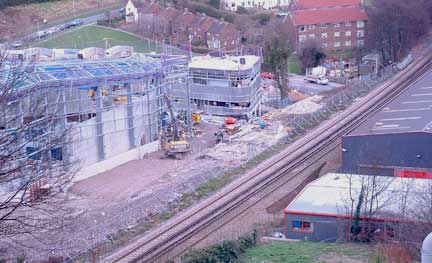
DEPENDENCE ON LANDSCAPING BEYOND THE APPLICANT'S CONTROL - its removal by Network Rail was predictable.
The DESIGN STATEMENT PAGE 7 - LANDSCAPE APPRAISAL & LANDSCAPE TREATMENT document supporting Veolia's 2006 planning application reads:
My October 2007 picture (above) shows what remained of the extensive bank of mature vegetation adjacent to The Waste Transfer Station while construction of Veolia's installations at Hollingdean Depot was taking place. Space was needed for 44-tonne trucks to access the southern perimeter of the installation. See pictures below:
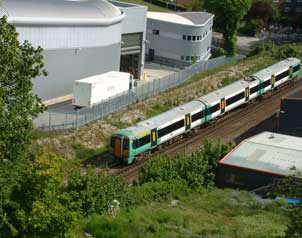
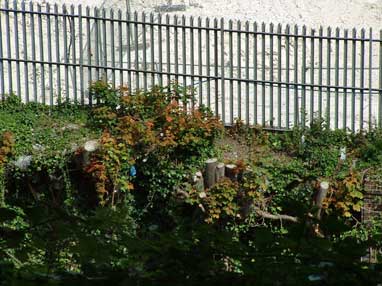
The removal of much of the extensive bank of mature vegetation to the south of the site means that The Round Hill Conservation Area lacks screening from The Waste Transfer Station, which is evident from the junction of Princes Road and Mayo Road. It was predictable that Network Rail would remove this with 44-tonne lorries circulating so close to their track. In planning terms, "dependence on landscaping beyond the applicant's control" is unacceptable. Landscaping was omitted on the southern border within Hollingdean Depot because the site is too small for both a Materials Recovery Facility and a Waste Transfer Station. A split site solution, as envisaged in 2003, would have meant there was room for landscaping.
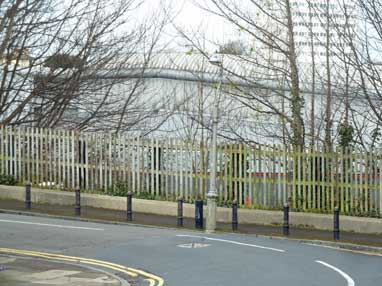
While we have managed to protect our cast iron Victorian street lamps - the Council has added four type 1 columns in Princes Road to its local list of heritage assets - valued street furniture in the north of the Round Hill conservation area has not been screened from industrial development at Hollingdean Depot.
Breach of planning condition 16
March 2012 - breach of planning condition 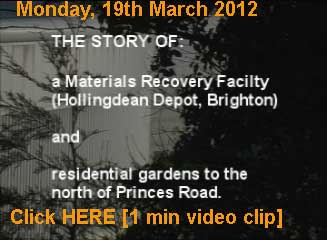 Condition 16 of The Council's planning conditions for Veolia's
Condition 16 of The Council's planning conditions for Veolia's
MRF and WTS requires: doors to be kept closed when lorries are not going in or out
Tipping while doors are open
The Council's planning conditions, which include condition 16 requiring doors of the MRF/WTS to be kept closed when lorries are not going in or out, are somewhat different from those set by The Environment Agency, which grants Veolia a licence to operate its facilities. 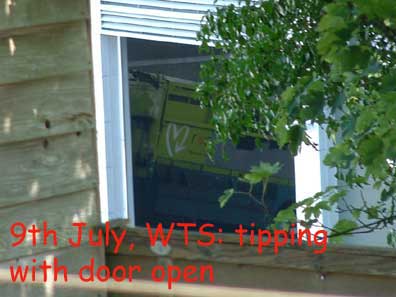
If one or more of the Council's planning conditions are being breached - e.g. condition 16 forbids leaving doors open while no vehicle is entering or leaving the WTS/MRF - contact Brighton and Hove City Council's Senior Environmental Health Officer.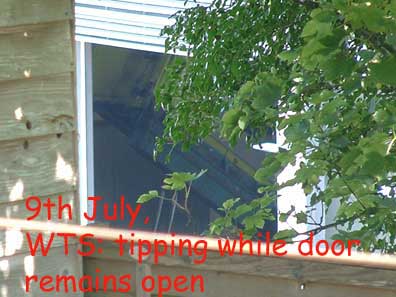
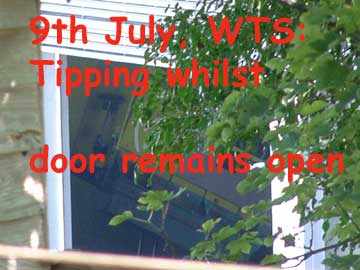
The Council's sparse resources for enforcement affords little protection to neighbouring residents in relation to noise, odour and fugitive particles 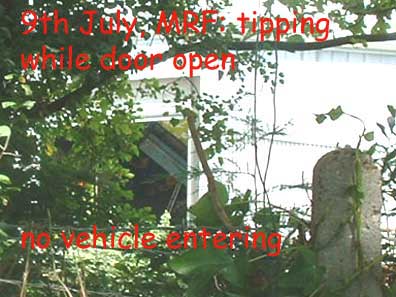
Keeping a nuisance diary
During the early summer of 2009, the Environmental Health Officer suggested that local residents should keep diaries to log the nuisances caused by the WTS and MRF.
My own noise diary was written in 2009, though since 2010 odour has been reported by many local residents as the major nuisance.
Reporting systematically and for significant periods of time on unpleasant nuisances has the disadvantage of making them the centrepiece of residents' lives. Should it not be the wider public purse (Council & EA) which is monitoring these nuisances? Are the Council and EA not abdicating their responsibilities by making the residents most affected by pollution into the front-line monitors?
Local residents' comments
Wastewatch comment - 10 Feb 2010
"Horrible acrid smell for most of afternoon Tuesday 9 Feb on Princes Road, and in our garden. This is almost daily I can smell the WTF in Princes Road."
(Householder living towards the west end of Princes Road)
Comment from Hollingdean - 6 Feb 2010
Rob Stephenson receives a phone call from a lady living off Davey Drive (Widmore Close) saying there was a terrible smell from tip last week (the last week of January).
Wastewatch comment - 26 Jan 2010
"There has been an appalling smell every day for the last week or so in Princes Road. Particularly bad in the mornings"
(Householder living near junction of Princes Rd and Crescent Rd)
Ward Councillor Pete West's comment - 24 Jan 2010
On the morning of 24th January there was a very strong and unpleasant odour present along the whole length of the road. It was strongest at the top, nearest the Waste Transfer Station. Personally I found it quite nauseating. One resident near the top of the road stated that this was not an unusual state of affairs, the stink from the dump is present at least twice a week regardless of busy or difficult periods around the holidays or as experienced with the disruption caused by the snow. I am pretty dismayed by this, as ward councillors have been repeatedly assured that smells are contained and neutralised. I also noted that the noise from machinery at the WTS was pretty loud, and this is contrary to reassurances we have been given too. Cllr Davey and I visited the site earlier last year and were told the problems experienced at the beginning of last year were teething troubles now resolved. This seems does not seem to have been the case, can you explain how it is that these issues have persisted and what contractors are being asked to do to prevent them.
Noise impact assessment not robust
The Noise impact assessment prepared by Clarke Saunders Associates when Veolia's operating hours were extended (see BH2013/02219) was described by The Council's Environmental Health Officer as "robust" without any of the critical appraisal offered by Councillors Hamilton, Wells and Hyde at The Planning Committee Meeting. At least three of the elected Councillors drew attention to the distance of the monitoring positions selected by the acoustic monitoring company from the Hollingdean Depot site.
The noise impact assessment for BH2013/02219 religiously named every piece of equipment and process within the depot responsible for noise, but failed to monitor the noise from any of the 300 or so households nearest to the depot. It is as if these households responsible for the most complaints were wiped off the map.
No microphones were located within the homes and gardens of the residents' affected by industrial noise (i.e. behind the line of houses on the north side of Princes Road, in Mayo Road or Crescent Road). Monitoring positions from within Round Hill were from Richmond Road/D'Aubigny Rd near to the Centenary Industrial Estate, and from Wakefied Road/Richmond Road/Princes Crescent. On the Hollingdean side of The Waste Transfer Station, no microphones were located in the vicinity of the two residential tower blocks (Dudeney Lodge and Nettleton Court) in Upper Hollingdean Road or Davey Drive or in the Downs Infant School playground. The monitoring positions were in Horton Road and Rugby Road significantly more distant from the residential properties which experience the most noise. See page 11 point 5.3.1 of Noise impact assessment.
Update 2024 Although one gets used to noise, the reality is that being in the garden can be like being on a noisy industrial estate. The problem of odour is harder to get used to. It occurs during hot sunny weather, the very time when one wants to be in the garden and not inside one's home with doors and windows shut.
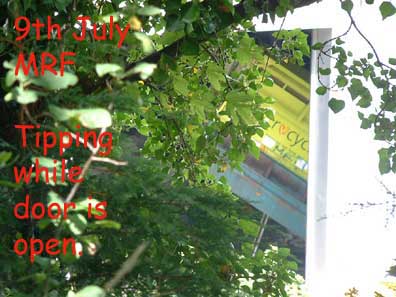
SUMMARY
What specifically do residents want their local planners and political representatives to address?
2025 Update:
do not add pressure to a poorly located & designed WTS on a constrained site.
It has proved easier to live with The Materials Recovery Facility in spite of its size. Although there is some nervousness that reconfiguration of the MRF to handle an extended range of materials will change this, the major nuisances compromising the well-being of nearby residents are caused by The Waste Transfer Station.
The lack of an airlock entry system makes it impossible to maintain negative air pressure within it so it is impossible to contain odour and dust particles when the doors are opened. This is a consequence of it being on a very constrained site; otherwise the goal of nearby residents would be to press for the addition of an airlock entry system if there were space for it. The spatial constraints are the result of the commercial preference to put both the MRF and the WTS on a single site, which was neither envisaged by the inspector who led the 2003 public inquiry into objections to Brighton and Hove City Council's and East Sussex County Council's Waste Local Plan, nor what was documented in the 2005 Brighton & Hove Local Plan where Hangleton Bottom was envisaged as a site for a Materials Recovery Facility. In these circumstances, it would be folly to put more pressure on the Hollingdean WTS, by adding another fleet of heavy vehicles to Hollingdean Depot and using it to process food waste.
An alternative site needs to be found for another WTS dedicated to processing food waste and care needs to be given to follow best practice and incorporate an airlock entry system so that any residents living nearby do not experience the same pollution events that we have had to put up with for many years.
Non compliance among residents with separate food waste collections would mean a proportion of food waste continues to be mixed in with black bag waste going to The Hollingdean Waste Transfer Station and then for incineration, so it important to take as much pressure off Hollingdean Depot as possible to mitigate against the poor design of the WTS.
Hollingdean Depot can expect extra pressure from the extension of the range of materials that can be recycled. The expanded range of materials will include food and drinks cartons such as fruit juice and plant-based milks, aluminium foil, foil tray and plastic pots, tubs and trays which includes items like yogurt pots, fruit trays and margarine tubs. Councillor Rowkins, Cabinet Member for Net Zero & Environmental Services, states that “The primary obstacle to accepting more items is the size and configuration of our Materials Recovery Facility. We are working on plans to address this.”
(a) Pollution in the form of noise, odour and dust particles, permitted to escape through the frequently opened doors of a Waste Transfer Station, causing nuisance to nearby residents.
(b) The continued absence of adequate landscaping.
(c) The poor construction of the WTS/MRF buildings RE containment of the pollution: the lack of double doors/filtration: "The building was built without an entrance airlock system, so there is no barrier between the waste and the open air when the doors are opened and this allows odour to escape." [The Environment Agency].
(d) Profit / cost minimisation before people's health. Why should the maximum permitted capacity remain at 160,000 tonnes per annum, significantly greater than is needed to service Brighton and Hove residents' domestic waste, while the odour nuisance continues and is also caused by smelly waste being imported fron outside our city? Hasn't the Environment Agency got any lever to stop this?
(e) Operating Licences (licences to pollute) which fail to set precise limits to manage AND PREVENT odour/dust particle/noise pollution. Instead, the Environment Agency's ongoing system of regulation requires local residents to suffer (i) POLLUTION EVENTS and (ii) sufficient anger and stress to telephone whichever of their officers is logging complaints.
The terms of the licence to pollute given by the EA to Veolia (which is not obliged to monitor the effects of its operation) then leave it to the discretion of the EA's officers as to whether (iii) to believe local residents or (iv) require Veolia to take any action.
The protection of public health is the duty of EA. Making the mechanism conditional on complaint neither respects the mental or physical health of the worst affected residents. The EA's mechanism guarantees rather than controls pollution. Failure to intervene means that there is no end to unreasonable industrial noise and odour escapes which have tried the patience of immediate neighbours since 2008. A better funded EA would be much more proactive, carrying out regular scientific checks on odour, noise and escapes of fugitive particles. Instead, this gross nuisance to immediate neighbours continues unchequed, giving little incentive even for more considerate site management.
(f) The polluter's requests for "lenience RE the problem of odour during weekends following Public Holidays" should trigger sanction by the Environment Agency rather than be allowed to try the patience of local residents.
Other campaigns involving Waste Transfer Stations
